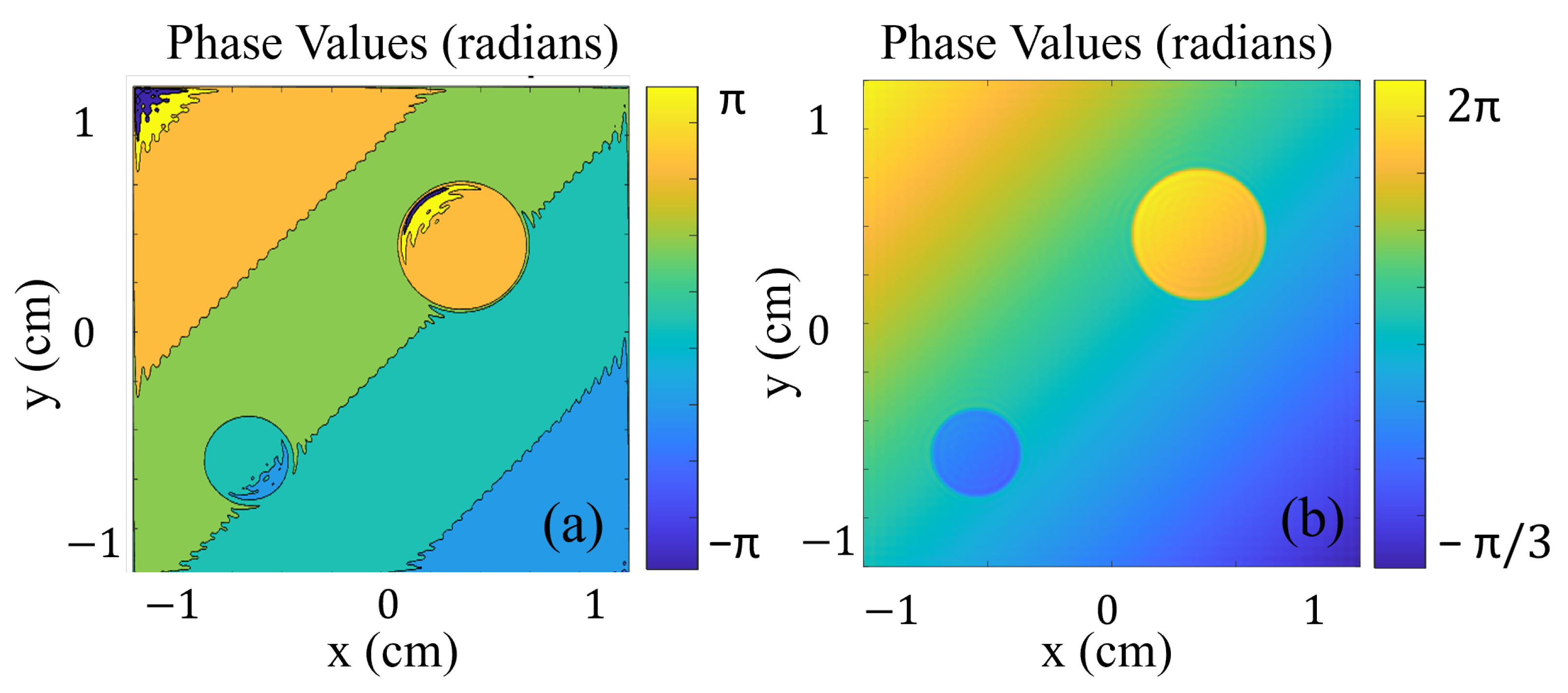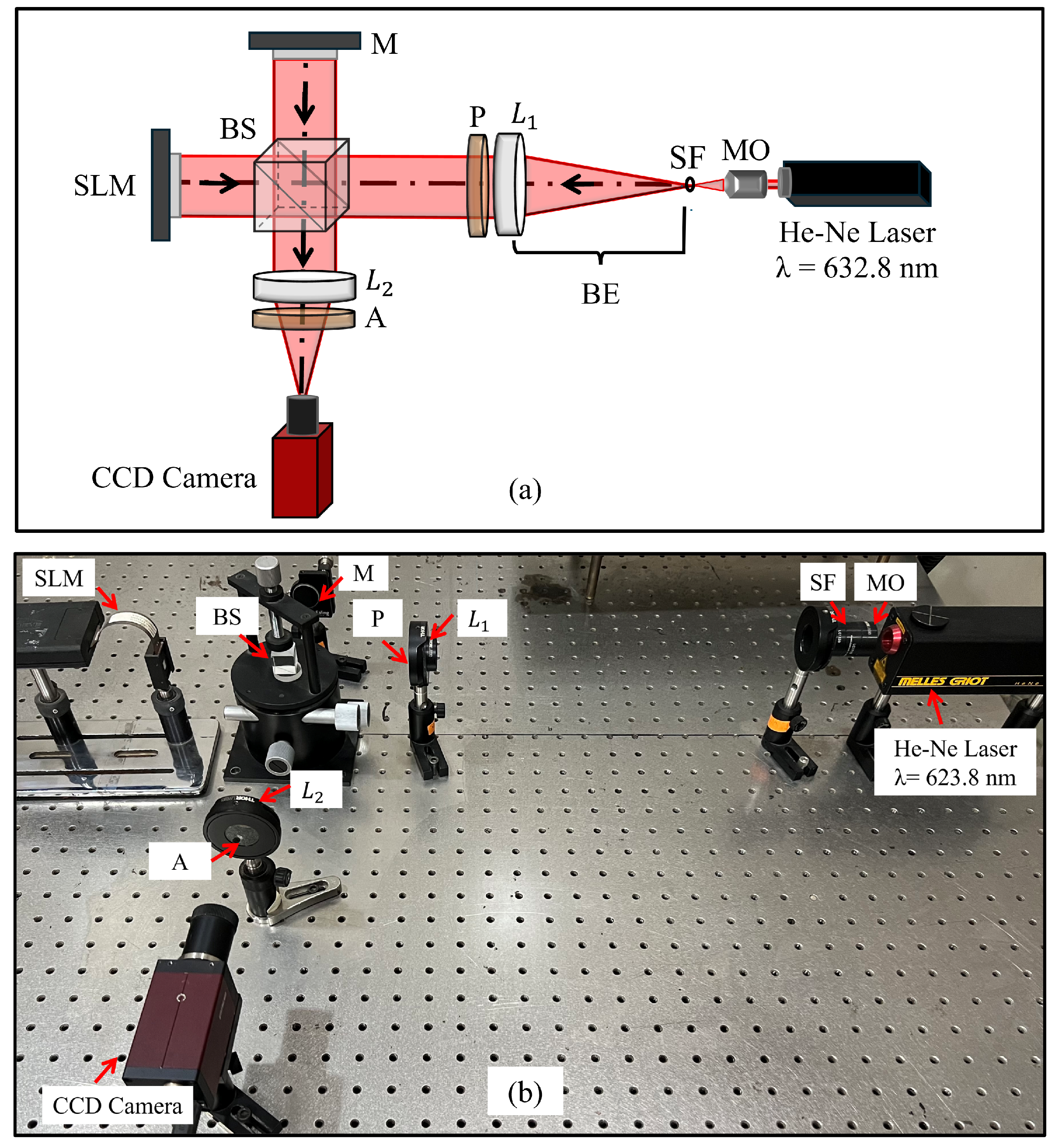Interferometric Surface Analysis of a Phase-Only Spatial Light Modulator for Surface Deformation Compensation
Abstract
1. Introduction
2. Filtering of Noise from the Recorded Interferograms
3. Simulation Results
4. Experimental Setup
5. Experimental Results
5.1. Noise Reduction and Phase Extraction
5.2. Surface Deformation Compensation Based on the Estimated Phase
- Reconstructing the phase map of the SLM surface after noise reduction and reference wave compensation;
- Modeling of residual deformations using a two-dimensional polynomial fit;
- Displaying the inverted fitted phase function as a compensation map on the SLM;
- Verification of the flatness of the SLM surface through interferometric measurements and phase analysis.
6. Conclusions
Author Contributions
Funding
Institutional Review Board Statement
Informed Consent Statement
Data Availability Statement
Conflicts of Interest
Abbreviations
| SLM | Spatial light modulator |
| LCOS | Liquid crystal on silicon |
| LC | Liquid crystal |
| LUT | Lookup table |
| CGH | Computer-generated hologram |
| SNR | Signal-to-noise ratio |
| MSE | Mean square error |
| RMS | Root mean square |
References
- Maxson, J.M.; Bartnik, A.C.; Bazarov, I.V. Efficient and accurate laser shaping with liquid crystal spatial light modulators. Appl. Phys. Lett. 2014, 105, 171109. [Google Scholar] [CrossRef]
- Falldorf, C.; Agour, M.; Von Kopylow, C.; Bergmann, R.B. Phase retrieval for optical inspection of technical components. J. Opt. 2012, 14, 065701. [Google Scholar] [CrossRef]
- Bawart, M.; Bernet, S.; Ritsch-Marte, M. Programmable freeform optical elements. Opt. Express 2017, 25, 4898–4906. [Google Scholar] [CrossRef] [PubMed]
- Cai, Y.; Yan, S.; Wang, Z.; Li, R.; Liang, Y.; Zhou, Y.; Li, X.; Yu, X.; Lei, M.; Yao, B. Rapid tilted-plane Gerchberg-Saxton algorithm for holographic optical tweezers. Opt. Express 2020, 28, 12729–12739. [Google Scholar] [CrossRef]
- Abdelazeem, R.M.; Agour, M. Color holographic visualization of an abnormal retina: A training guide. In Proceedings of the 2022 4th Novel Intelligent and Leading Emerging Sciences Conference (NILES), Giza, Egypt, 22–24 October 2022; IEEE: Piscataway, NJ, USA, 2022; pp. 186–189. [Google Scholar]
- Ibrahim, D.G.A.; Abdelazeem, R.M. Quantitative phase imaging by automatic phase shifting generated by phase-only spatial light modulator. In Proceedings of the Frontiers in Optics, Washington, DC, USA, 1–4 November 2021; Optical Society of America: Washington, DC, USA, 2021; p. JTh5A.104. [Google Scholar]
- Crossland, W.; Wilkinson, T.; Manolis, I.; Redmond, M.; Davey, A. Telecommunications applications of LCOS devices. Mol. Cryst. Liq. Cryst. 2002, 375, 1–13. [Google Scholar] [CrossRef]
- Olakanmi, E.O.; Cochrane, R.F.; Dalgarno, K.W. A review on selective laser sintering/melting (SLS/SLM) of aluminium alloy powders: Processing, microstructure, and properties. Prog. Mater. Sci. 2015, 74, 401–477. [Google Scholar] [CrossRef]
- Gardner, M.R.; Lewis, A.; Park, J.; McElroy, A.B.; Estrada, A.D.; Fish, S.; Beaman, J.J.; Milner, T.E. In situ process monitoring in selective laser sintering using optical coherence tomography. Opt. Eng. 2018, 57, 041407. [Google Scholar] [CrossRef]
- Abdel-Harith, M.; Abdelazeem, R.M.; Hamdy, O.; Abdel-Salam, Z. Adaptive optics-based wavefront-enhanced laser-induced fluorescence (WELIF) for improved analytical performance. Anal. Methods 2023, 15, 212–220. [Google Scholar] [CrossRef] [PubMed]
- Abdelazeem, R.M.; Ahmed, M.M.; Hassab-Elnaby, S.; Agour, M. Adaptive phase control of a phase-only spatial light modulator using the Shack-Hartmann wavefront sensor. Appl. Opt. 2024, 63, G54–G62. [Google Scholar] [CrossRef]
- Bergeron, A.; Gauvin, J.; Gagnon, F.; Gingras, D.; Arsenault, H.H.; Doucet, M. Phase calibration and applications of a liquid-crystal spatial light modulator. Appl. Opt. 1995, 34, 5133–5139. [Google Scholar] [CrossRef]
- Chandra, A.D.; Banerjee, A. Rapid phase calibration of a spatial light modulator using novel phase masks and optimization of its efficiency using an iterative algorithm. J. Mod. Opt. 2020, 67, 628–637. [Google Scholar] [CrossRef]
- Servin, M.; Estrada, J.; Quiroga, J.; Mosiño, J.; Cywiak, M. Noise in phase shifting interferometry. Opt. Express 2009, 17, 8789–8794. [Google Scholar] [CrossRef] [PubMed]
- Takiguchi, Y.; Otsu, T.; Inoue, T.; Toyoda, H. Self-distortion compensation of spatial light modulator under temperature-varying conditions. Opt. Express 2014, 22, 16087–16098. [Google Scholar] [CrossRef] [PubMed]
- Falldorf, C.; Agour, M.; von Kopylow, C.; Bergmann, R.B. Design of an optical system for phase retrieval based on a spatial light modulator. AIP Conf. Proc. 2010, 1236, 259–264. [Google Scholar]
- Yue, H.; Song, L.; Hu, Z.; Liu, H.; Liu, Y.; Liu, Y.; Peng, Z. Characterization of the phase modulation property of a free-space electro-optic modulator by interframe intensity correlation matrix. App. Opt 2012, 51, 19. [Google Scholar] [CrossRef]
- Reichelt, S. Spatially resolved phase-response calibration of liquid-crystal-based spatial light modulators. Appl. Opt. 2013, 52, 2610–2618. [Google Scholar] [CrossRef]
- Li, R.; Cao, L. Progress in phase calibration for liquid crystal spatial light modulators. Appl. Sci. 2019, 9, 2012. [Google Scholar] [CrossRef]
- Li, R.; Gao, Y.; Cao, L. In situ calibration for a phase-only spatial light modulator based on digital holography. Opt. Eng. 2020, 59, 053101. [Google Scholar] [CrossRef]
- Yang, L.; Xia, J.; Chang, C.; Zhang, X.; Yang, Z.; Chen, J. Nonlinear dynamic phase response calibration by digital holographic microscopy. Appl. Opt. 2015, 54, 7799–7806. [Google Scholar] [CrossRef]
- Agour, M.; Falldorf, C.; Bergmann, R.B. Spatial multiplexing and autofocus in holographic contouring for inspection of micro-parts. Opt. Express 2018, 26, 28576–28588. [Google Scholar] [CrossRef]
- Yang, S.; Zhang, G. A review of interferometry for geometric measurement. Meas. Sci. Technol. 2018, 29, 102001. [Google Scholar] [CrossRef]
- Yamaguchi, I.; Liu, J.-Y.; Kato, J.-i. Active phase-shifting interferometers for shape and deformation measurements. Opt. Eng. 1996, 35, 2930–2937. [Google Scholar] [CrossRef]
- Takeda, M.; Ina, H.; Kobayashi, S. Fourier-transform method of fringe-pattern analysis for computer-based topography and interferometry. J. Opt. Soc. Am. 1982, 72, 156–160. [Google Scholar] [CrossRef]
- Huntley, J.M. Automated fringe pattern analysis in experimental mechanics: A review. J. Strain Anal. Eng. Des. 1998, 33, 105–125. [Google Scholar] [CrossRef]
- Kogelnik, H.; Li, T. Laser beams and resonators. Appl. Opt. 1966, 5, 1550–1567. [Google Scholar] [CrossRef]
- Kreis, T. Handbook of Holographic Interferometry: Optical and Digital Methods; John Wiley & Sons: Weinheim, Germany, 2004. [Google Scholar]
- Goodman, J. Introduction to Fourier Optics; Roberts and Company Publishers: Greenwood Village, CO, USA, 2005. [Google Scholar]
- Papoulis, A. Random Variables and Stochastic Processes; McGraw Hill: New York, NY, USA, 1965. [Google Scholar]
- Agour, M.; El-Farahaty, K.; Seisa, E.; Omar, E.; Sokkar, T. Single-shot digital holography for fast measuring optical properties of fibers. Appl. Opt. 2015, 54, E188–E195. [Google Scholar] [CrossRef] [PubMed]
- Herráez, M.A.; Burton, D.R.; Lalor, M.J.; Gdeisat, M.A. Fast two-dimensional phase-unwrapping algorithm based on sorting by reliability following a noncontinuous path. Appl. Opt. 2002, 41, 7437–7444. [Google Scholar] [CrossRef]
- Gonzalez, R.C. Digital Image Processing; Pearson Education India: Noida, India, 2009. [Google Scholar]
- Holoeye. Application Note: Spatial Light Modulators (SLM)—Version 6.0. Available online: https://holoeye.com/wp-content/uploads/Application_Note_SLM-V.60.pdf (accessed on 4 March 2025).
- Persson, M.; Engström, D.; Goksör, M. Reducing the effect of pixel crosstalk in phase only spatial light modulators. Opt. Express 2012, 20, 22334–22343. [Google Scholar] [CrossRef]
- Li, J. Refractive Indices of Liquid Crystals and Their Applications in Display and Photonic Devices; University of Central Florida: Orlando, FL, USA, 2005. [Google Scholar]









Disclaimer/Publisher’s Note: The statements, opinions and data contained in all publications are solely those of the individual author(s) and contributor(s) and not of MDPI and/or the editor(s). MDPI and/or the editor(s) disclaim responsibility for any injury to people or property resulting from any ideas, methods, instructions or products referred to in the content. |
© 2025 by the authors. Licensee MDPI, Basel, Switzerland. This article is an open access article distributed under the terms and conditions of the Creative Commons Attribution (CC BY) license (https://creativecommons.org/licenses/by/4.0/).
Share and Cite
Abdelazeem, R.M.; Agour, M.; Elnaby, S.H. Interferometric Surface Analysis of a Phase-Only Spatial Light Modulator for Surface Deformation Compensation. Photonics 2025, 12, 285. https://doi.org/10.3390/photonics12030285
Abdelazeem RM, Agour M, Elnaby SH. Interferometric Surface Analysis of a Phase-Only Spatial Light Modulator for Surface Deformation Compensation. Photonics. 2025; 12(3):285. https://doi.org/10.3390/photonics12030285
Chicago/Turabian StyleAbdelazeem, Rania M., Mostafa Agour, and Salah Hassab Elnaby. 2025. "Interferometric Surface Analysis of a Phase-Only Spatial Light Modulator for Surface Deformation Compensation" Photonics 12, no. 3: 285. https://doi.org/10.3390/photonics12030285
APA StyleAbdelazeem, R. M., Agour, M., & Elnaby, S. H. (2025). Interferometric Surface Analysis of a Phase-Only Spatial Light Modulator for Surface Deformation Compensation. Photonics, 12(3), 285. https://doi.org/10.3390/photonics12030285




